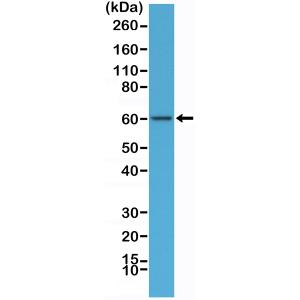Anti-AMPK alpha 1 + AMPK alpha 2 Rabbit mAb
Catalog number :AT0611
AMP-activated protein kinase (AMPK) is highly conserved from yeast to plants and animals and plays a key role in the regulation of energy homeostasis. AMPK is a heterotrimeric complex composed of a catalytic α subunit and regulatory β and γ subunits, each of which is encoded by two or three distinct genes (α1, 2; β1, 2; γ1, 2, 3). The kinase is activated by an elevated AMP/ATP ratio due to cellular and environmental stress, such as heat shock, hypoxia, and ischemia. The tumor suppressor LKB1, in association with accessory proteins STRAD and MO25, phosphorylates AMPKα at Thr172 in the activation loop, and this phosphorylation is required for AMPK activation. AMPKα is also phosphorylated at Thr258 and Ser485 (for α1; Ser491 for α2). The upstream kinase and the biological significance of these phosphorylation events have yet to be elucidated. The β1 subunit is post-translationally modified by myristoylation and multi-site phosphorylation including Ser24/25, Ser96, Ser101, Ser108, and Ser182. Phosphorylation at Ser108 of the β1 subunit seems to be required for the activation of AMPK enzyme, while phosphorylation at Ser24/25 and Ser182 affects AMPK localization. Several mutations in AMPKγ subunits have been identified, most of which are located in the putative AMP/ATP binding sites (CBS or Bateman domains). Mutations at these sites lead to reduction of AMPK activity and cause glycogen accumulation in heart or skeletal muscle. Accumulating evidence indicates that AMPK not only regulates the metabolism of fatty acids and glycogen, but also modulates protein synthesis and cell growth through EF2 and TSC2/mTOR pathways, as well as blood flow via eNOS/nNOS.
- Overview
- Reactivity
- Mouse, Rat, Human, Drosophila melanogaster
- Tested applications
- Western Blot: 1:1000-1:3000Immunocytochemistry/Immunofluorescence: 1:100-1:200Immunohistochemistry: 1:100-1:200
- Specificity
- AMPK alpha Antibody detects endogenous levels of AMPKα protein. The antibody detects both the α1 and α2 isoforms of the catalytic subunit, but it does not detect the regulatory β or γ subunits.
- Properties
- Immunogen
- 29 amino acid peptide designed within the N-terminal catalytic domains of Drosophila AMPK alpha 1 and 2
- Clonality
- Monoclonal, clone number: 3BF7
- Isotype
- Rabbit IgG
- Form
- Liquid, 100 μl,1mg/ml
- Storage instruction
- Store at +4°C short term (1-2 weeks). Aliquot and store at -20°C
- Applications
- WB Image

Western Blot: AMPK alpha 1/2 Antibody - Analysis HeLa cells lysate.
Related Products
Reviews
loading...